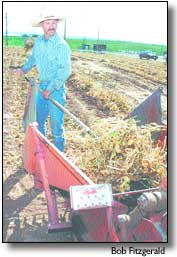|
Sept 29, 2001
By Janelle Holden The state of the 2001 pinto-bean crop can be summed up in a simple statement ó high-quality, but with low to average yields. "The quality is very, very good, but the quantity is less than average," commented Rod Tanner at the Midland Bean Company about area dryland beans. Midland is taking in less than 300 pounds of beans per acre, according to Tanner, who said they are about 65 to 70 percent done with their processing. "I guess for no rain theyíre not too bad," said Dove Creek farmer Jay Allen. "Itís pretty amazing that we went with no rain for so long and got anything at all." Allen estimated that he averaged anywhere from 330 pounds of dryland beans per acre to 609 pounds per acre. Dryland pinto-bean farmers suffered from a lack of winter moisture and virtually no rainfall in July, and while irrigated bean crops fared better, outbreaks of white mold hampered production. "Itís a good year for irrigated farming," said Mark Stack, the manager of the CSU Yellow Jacket research station. Stack said the 30 acres of irrigated pinto beans planted at the research station yielded an average to better-than-average crop, despite an outbreak of white mold and a wetter-than-usual August. "Every year I think it gets worse," Stack said about the mold, "so weíre going to have to start using different tactics." The tactics include widening the bean rows and using fungicides. In a normal year, only 1.6 inches of rain falls in August, but this August 2.75 inches fell. The research station took in a little more than 8 inches of moisture since January, down by 1.8 inches from the 30-year average. "That helped the (dryland) beans a lot because thatís when they flower and make seeds," said Abdel Berrada, a researcher at the station. Dryland bean production at the center ranged from 355 pounds per acre to 734. Yields can vary wildly depending on the moisture. In 1999, a banner year for beans, the research station harvested 800 to 900 pounds per acre of dryland beans, but last yearís yields, because of the drought, were down in some areas to 130 pounds per acre. Berrada said the critical factor in raising dryland beans is getting enough winter moisture to keep the plants watered through a normally dry June, and enough moisture to keep them growing through July and August. This year only nine-tenths of an inch fell in July; the 30-year average is 1.6 inches. June, May, and March were particularly dry months this year, while April and August made up the difference. One piece of good news for bean-growers is the commodity price, which jumped from $18 per hundred pounds to $23 per hundred this fall. |
||
|
Copyright © 2001 the Cortez Journal.
All rights reserved. |
